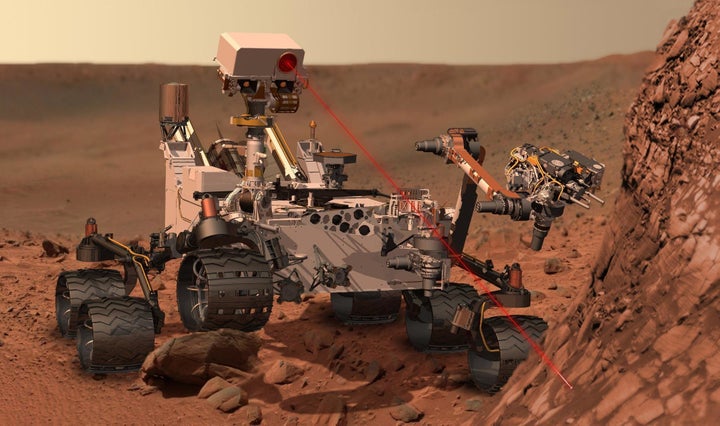
NASA's Mars Rover Curiosity fired its laser beam for the first time on Mars over the weekend, blasting a small rock called "Coronation" with 30 high-energy laser pulses, the space agency said on Sunday.
The laser is emitted from the Chemistry and Camera instrument, or ChemCam, a tool that analyzes Martian rock and soil to determine the composition.
NASA described the rock, which was previously known as N165, as roughly the size of a fist.
SCROLL DOWN FOR IMAGE OF ROCK
According to the agency, the ChemCam uses what's called laser-induced breakdown spectroscopy. It emits powerful laser pulses -- each one blasts over a million watts -- to energize atoms in the target rock, turning them "into an ionized, glowing plasma." A telescope captures the light from the plasma, and then three on-board spectrometers analyze it to determine the composition.
"We got a great spectrum of Coronation -- lots of signal," Roger Wiens, ChemCam Principal Investigator, said in a NASA statement. "Our team is both thrilled and working hard, looking at the results. After eight years building the instrument, it's payoff time!"
While laser-induced breakdown spectroscopy has been used on Earth to analyze materials on the sea floor and inside nuclear reactors, NASA said that this is the first time it's been used on another planet.
The ChemCam will eventually be used to determine material composition, but Sunday's zap was essentially target practice for the instrument.
Sylvestre Maurice, the ChemCam Deputy Project Scientist, said in the statement that the instrument has the potential to analyze "thousands of targets" over the next several years.
Curiosity, which weighs a ton and is the size of a small SUV, landed on Mars on Aug. 6 and has already sent back stunning images.
Scientists said last week that the rover will "exercise" its wheels and go on short test drives in the coming days.
Curiosity's mission will span two years and help scientists determine if portions of the red planet ever had conditions that could have been suitable for microbial life.
Click here to see a high-resolution self-portrait of the rover.
CORRECTION: A headline in a previous version of this article incorrectly identified Curiosity as Opportunity. Opportunity is a rover that NASA launched in 2003 and has been active on Mars since landing in 2004.
